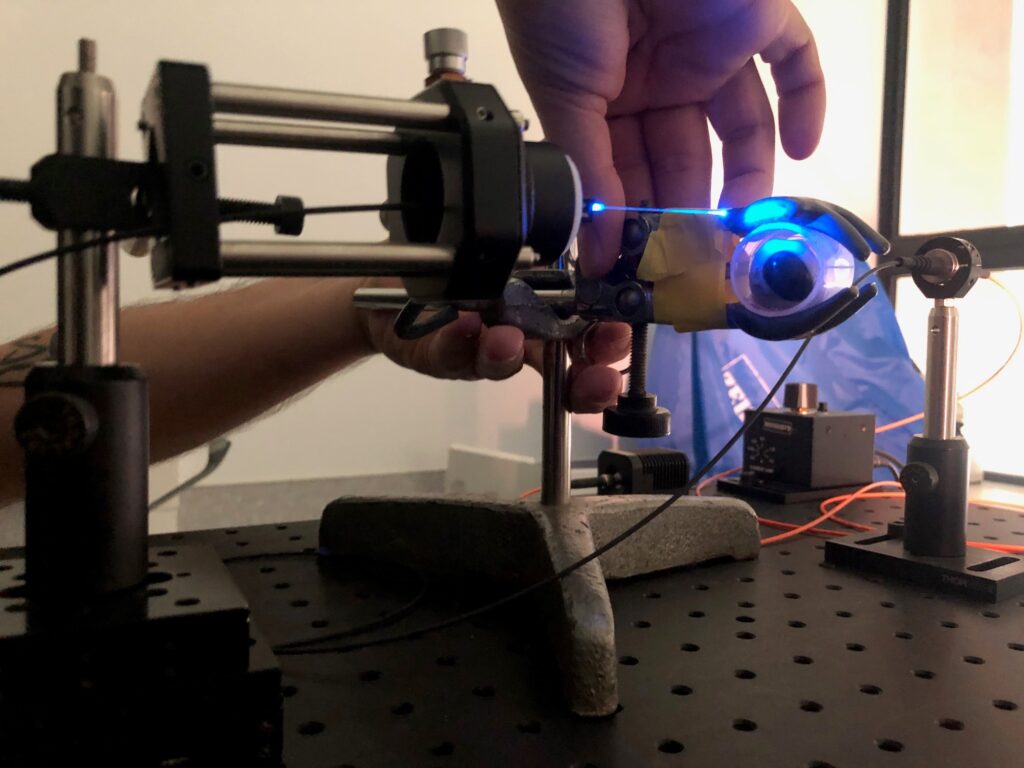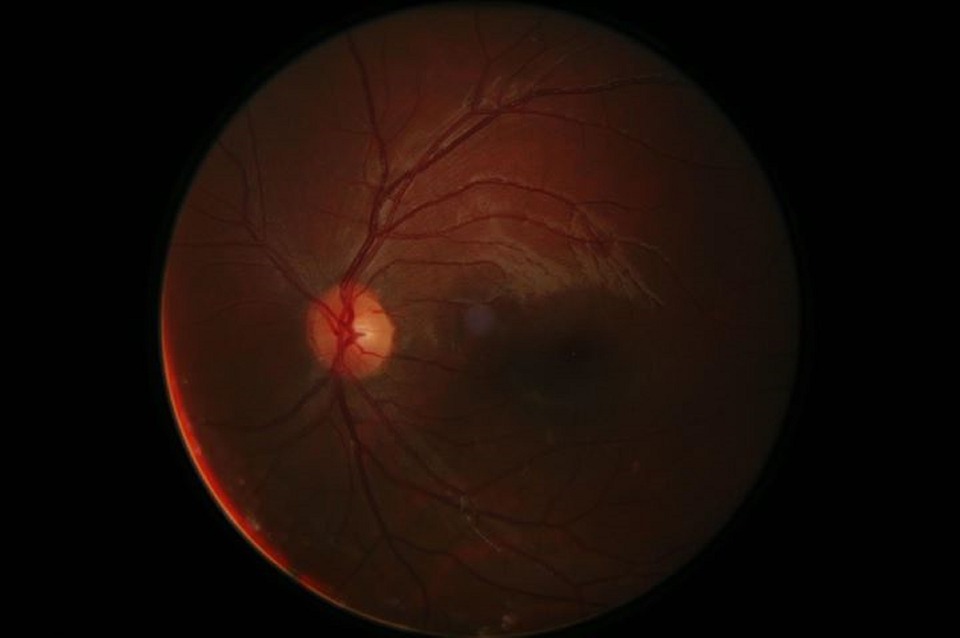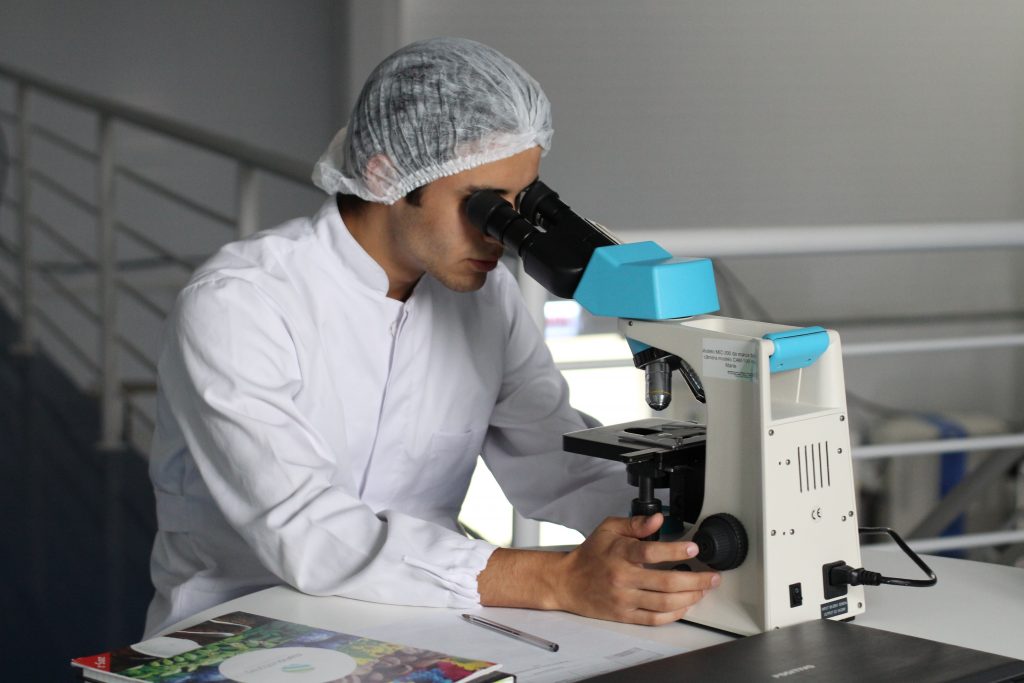The Science Behind MyopiaX®
How does MyopiaX® Work?
MyopiaX® modulates melanopsin-mediated dopamine release to slow the progression of myopia
MyopiaX® administers selective ocular light stimulation, targeting the eye’s blind spot. This scientifically developed light stimulus aims to activate a network of cells in the retina to increase dopamine release. Dopamine, a crucial neurotransmitter in the retina, plays a significant role in innate eye growth regulation mechanisms. The light in MyopiaX® stimulates specific photosensitive cells that communicate with dopaminergic amacrine cells, engaging this unique modulatory pathway.
By engaging this pathway, MyopiaX® aims to effectively activate the signaling cascade from light exposure to dopamine release. It is hypothesized that this stimulation efficiently increases the release of retinal dopamine and has the potential to regulate eye growth, and therefore impact the rate of myopia progression.


Our Research
Our comprehensive pre-clinical research has served as the basis for our development of MyopiaX® and submission for the clinical investigation of MyopiaX®. This scientific and technical documentation has been reviewed and approved by the relevant regulatory authorities and ethics committees in several European countries, permitting us to launch a multicentre randomized controlled trial investigating MyopiaX®.

Proof of concept
Pupil light response, retinal electrical activity, and changes in contrast sensitivity were measured in humans and confirm that our light stimulus targets and activates the necessary cells in the retina.

PRECLINICAL MODELS
An increase in dopamine was directly measured in preclinical non-human models. Targeted light stimulation has the potential to inhibit the development of experimental myopia as well.

Research Studies
In humans, sessions with MyopiaX® stimulation showed an effect on both the length of the eye and the choroidal thickness, an important biomarker of the eye’s structural changes in myopic individuals.
what is myopia?
Myopia is characterized by the inability to see far away objects clearly
Myopia, also called short- or nearsightedness, commonly occurs due to excessive elongation of the eyeball which causes incoming images to be focused in front of the retina, rather than on the retina. As myopia progresses, the eye continues to elongate. This increases the long-term risk of other ocular complications such as myopic maculopathy or retinal detachment that can lead to permanent vision loss.
The global prevalence of myopia is increasing rapidly and there is an urgent need to develop safe and effective myopia interventions. Around the world, scientific and clinical communities are actively engaging in research to better understand the causes of myopia in order to design effective solutions.
WHAT causes Myopia?
Myopia is caused by a complex interaction of genetic and environmental factors
While genetic influences are known to contribute to myopia development, changing environmental factors are thought to be the primary cause of the recent myopia boom.1
Among the many different theories of myopia, the role of dopamine in refractive error development has received significant research attention.2
Dopamine is a neurotransmitter that is hypothesized to contribute to eye growth regulation. It is well-established that dopamine is released in response to light by dopaminergic amacrine cells in the retina.3
Abnormal dopamine levels have been associated with myopia development.2 A lack of outdoor light as a result of spending more time indoors, particularly during the COVID-19 pandemic,4 is thought to increase the risk of developing myopia. This may be due to less light-induced dopamine release in the retina.2
1 Dolgin E. The myopia boom. Nature. 2015;519(276-278).
2 Zhou X, Pardue MT, Iuvone PM, Qu J. Dopamine signaling and myopia development: What are the key challenges. Prog Retin Eye Res. 2017;61:60-71.
3 Witkovsky, P. (2004). Dopamine and retinal function. Documenta ophthalmologica, 108(1), 17-39.
4 Wang, J., Li, Y., Musch, D.C., Wei, N., Qi, X., Ding, G., … & Qian, X. (2021). Progression of myopia in school-aged children after COVID-19 home confinement. JAMA ophthalmology, 139(3), 293-300.


How does MyopiaX® Work?
MyopiaX® modulates retinal dopamine levels to control the progression of myopia
MyopiaX® uses a scientifically developed light stimulus to activate a network of cells in the retina in order to increase dopamine production. The light used excites a subset of photosensitive cells that provide input to dopaminergic amacrine cells. By engaging this pathway, the design of MyopiaX® aims to effectively activate the signaling cascade from light exposure to dopamine release. It is hypothesized that this stimulation approach efficiently increases retinal dopamine production with the goal of regulating eye growth and slowing the rate of myopia progression in children.
Our Research
We have conducted a series of experiments in collaboration with academic partners around the world in order to develop and investigate our light stimulus.

PROOF OF CONCEPT
By assessing the pupil light response and measuring changes in contrast sensitivity, we confirmed that our light stimulus targets and activates the necessary cells in the retina.

PRECLINICAL MODELS
Using preclinical models, we directly measured an increase in dopamine. We also demonstrated that light has the potential to inhibit the development of experimental myopia.

PRECLINICAL DATA
In humans, retinal electrical activity increased after using MyopiaX®. One session with MyopiaX® also increased choroidal thickness, which is usually thinner in myopic individuals.
Myopiax® will undergo clinical investigation
A clinical trial is being prepared to test the efficacy of MyopiaX®
In collaboration with academic and clinical partners, Dopavision is preparing to launch a multicentric randomized controlled trial at sites across Europe. This clinical trial will investigate the ability of MyopiaX® to slow the progression of myopia in children. It will also evaluate the safety and its acceptability to parents, guardians, and their children. More than 230 children across the EU will be recruited to participate in this trial.



